BBC The Blue Planet Disc 4: Tidal Seas (2002)
 Index
Index 
BBC The Blue Planet Disc 4: Tidal Seas (2002) |
 Index Index 
|
As the moon orbits the Earth its gravitational pull causes the sea level all over the world to rise and fall. In the Bay of Fundy, Canada, two billion tonnes of water flow in and out each day - more than all the rivers on Earth combined. Five hundred finback whales come here to gorge on the rich herring pickings.
Believe it or not, the best 'back-heel' in the world belongs to a tiny sand bubbler crab. These beach-dwelling Aussies convert an entire beach into minute footballs as they work at breakneck speed to filter food out of sand grains. They religiously practise their skills every day as the tide goes out. And in South Africa the world's fastest snail surfs the waves on its big foot, hunting for food on the falling tide. Raccoons in British Columbia also have a passion for seafood. Twice a month the moon pulls with maximum force, making the sea level rise and fall even further than normal. And when the sea is as far out as possible, a female raccoon passes on a few tips in crab cracking to her youngsters.
On Christmas Island, land crabs time their annual migration to November and December nights when the tides are weak. They need weak tides for good reason - they must spawn in the sea and they are land crabs. They can't breathe or swim underwater, so they wait for weak tides to get into the water to shed their eggs - that way they're less likel to drown.
Off Florida, a small group of bottlenose dolphins have a cunning plan. As they work their way inland they are forcing mullet to leap right into their waiting mouths. One animal peels off from the group and swims rapidly in a circle, stirring up the mud and driving the fish towards the other dolphins that have lined up in a row. The fish leap out of the water at just the wrong moment and the dolphins feast until the tide retreats.
|
| 2:10 | Tidal bore sweeps up Amazon River in Brazil | 3:30 | Finback Whales feed on Herring (Bay of Fundy, Nova Scotia) | 5:25 | Cory's Shearwater feed on scraps from whales |
| 6:25 | Sand Bubbler Crab feeds on myofauna by sieving sand at low tide (Australia) | 7:50 | Clams bury themselves under sand | 8:35 | Grizzly Bears dig clams by smell Alaska |
| 10:00 | Snails emerge from sand (Table Mountain, South Africa) | 12:40 | Red Knot s? feed in mud at low tide (Britain) | 14:25 | Right-eyed? Flounder glides on tide, hunt invertebrates (New Zealand) |
| 15:25 | Osprey dives for Flounder | 16:10 | Sand Lancet buries in sand, feed on plankton; Dogfish prey on school of Sand Lancet | 18:30 | Mussels, Barnacles, Giant Kelp dry on rocky shore (VanCouver Island) |
| 19:40 | Raccoons feed on Red Rock Crab at spring tide | 22:00 | Bull Kelp bends in strong current of Nakwakto rapids (VanCouver Island) | 24:30 | Huge schools of Stingrays ride on current through rock arches to breed (Poor Knights Islands, New Zealand) |
| 25:20 | Two-spotted Demoiselle Fish feed on plankton, hide in caves along with Blue Maumau when current is low | 27:20 | Thimble Jellyfish swim towards sunlight: algae living inside their body give brown color(Caribbeans) | 29:20 | Razor Fish feed on plankton, hide in sand |
| 30:00 | Bottlenose Dolphin use sonar to locate Razor Fish beneath sand (Bahamas) | 32:00 | Stingrays and Nurse Sharks wait in Seagrass beds | 32:35 | Horse Conch preys on Tulip Snail |
| 33:55 | Hermit crabs compete for dead Tulip Snail shell | 35:40 | Nurse Sharks and Stingrays use electrical sense to detect invertebrates below sand | 36:45 | Tarpon an breathe air and prey on dozy Silversides in stagnant low tide (Florida mangroves) |
| 39:55 | Caribbean Flamingos feed on Brine Shrimp and Brine Flies, nest in salty mud (Bahamas) | 42:50 | Christmas Island Red Crabs lay eggs in ocean at low tide en mass to avoid drowning | 45:05 | Common Bottlenose Dolphin hunt for Mullet as a team in spring tide. |
 6:25 Sand Bubbler Crab |
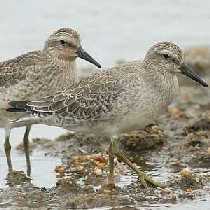 12:40 Red Knot s? |
 32:35 Horse Conch |
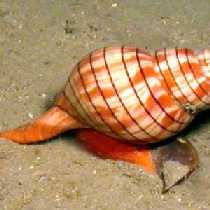 32:35 Tulip Snail |
 36:45 Tarpon |
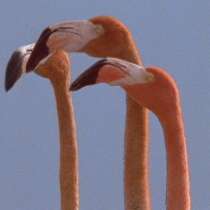 39:55 Caribbean Flamingos |
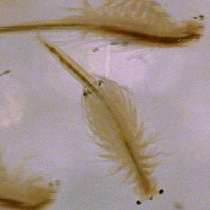 39:55 Brine Shrimp |
 42:50 Christmas Island Red Crabs |
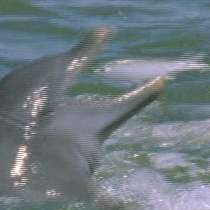 45:05 Common Bottlenose Dolphin |
| Index | Jan 19, 2006 |  Peter Chen Peter Chen |